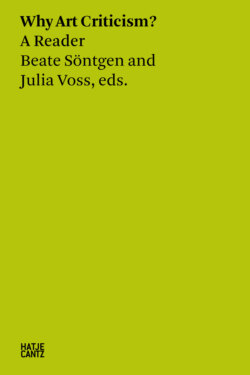Читать книгу Why Art Criticism? A Reader - Группа авторов - Страница 20
ОглавлениеRoger Fry
The critic, curator, painter, and interior design workshop founder Roger Fry is considered a formalist in art history. This title is not meant as an embellishment, considering that the term denotes a focus on questions entirely immanent to art, to the exclusion of social issues. Only recently has the perspective on this tireless writer and orator shifted, with emphasis now being placed on the communicative potential and societal functions of Fry’s notion of form. According to Fry, the process of production, the characteristics and manipulation of the material, as well as the joy of creation itself are retained in form and conveyed to the viewer. This transmittance of creative momentum led to the spiritualization of daily life, which, in Fry’s perspective, had been rendered desolate by commercialization and consumerism, as well as to the healing of individual and societal wounds caused by the war.
Post-Impressionism, the term Fry used to describe French painting around 1900, with its emphasis on the autonomy of form, order, rhythm, and sensually induced joy, served as his leitmotif. In England, it was primarily the paintings of Vanessa Bell that materialized this kind of understanding of art. Beauty in painting is not an end in itself, but rather an effect of the sincere, unconscious expression of feelings that resonate with their viewers and inspire their own creativity. The tacky Lawrence Alma Tadema appears here as a negative counterpoint, whose glossy paintings constituted part of the materialistic, commercial culture against which artists were expected to compete. The Futurists shared Fry’s notion that art should manifest one’s approach to life, as a figurative echo of mental visions. But their methods of countering their own, and in any case dubious, claims to originality were conventional, tending toward painted theory rather than genuine expression. Fry, who came from a wealthy London Quaker family, began as a curator specialized in early Italian painting, which shaped his understanding of modern painting. After working at the Metropolitan Museum in New York, he returned to London in 1910 and organized an exhibition of Post-Impressionist paintings. With the founding of the egalitarian and collectively organized artisanal craft workshop Omega in 1913, Fry wanted to incorporate the representational styles of the Post-Impressionists into everyday design, an undertaking which in itself invalidated all accusations of formalism.
Other members of Omega included Vanessa Bell and Duncan Grant, who were also part of the Bloomsbury group, with whom Fry maintained intense working, friendship, and love relationships. In the collective design and use of houses, such as the Charleston Farmhouse, as well as in the collective artisanal production of furniture and everyday utilitarian objects, alternative forms of life that restructured community relations materialized. Chosen family, artistic, intellectual and erotic bonds, as well as shared projects were at their foundation. Fry developed the criteria for his art criticism from these diverse artistic, artisanal, curatorial, teaching, and entrepreneurial practices. He discloses these criteria non-polemically, with a rhetorical elegance that employs wordplay, incisive anecdotes, and irony. Fry reveals where he stands in his texts, thus defending himself against the accusation of conflating aesthetics and ethics through a nuanced account of his notion of artistic morality. Taking the review of the Futurists as an example, it becomes clear how artistic processes can become social models; by communicating interior life as it is conveyed through form, and through the reciprocal relationships of parts of the whole.
